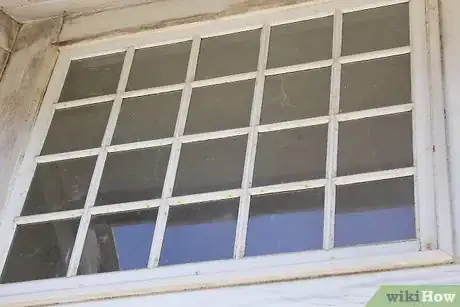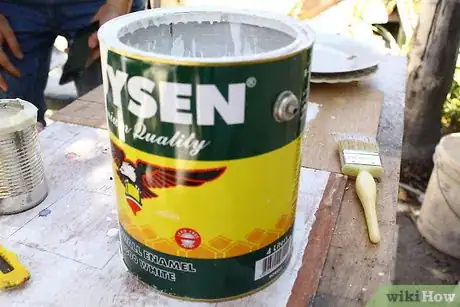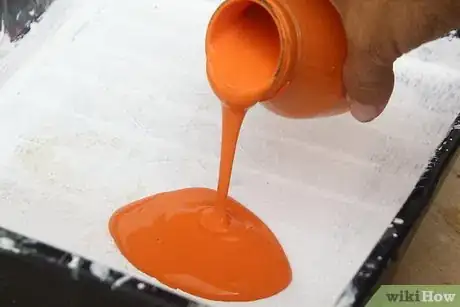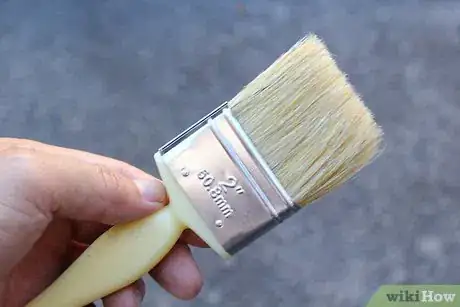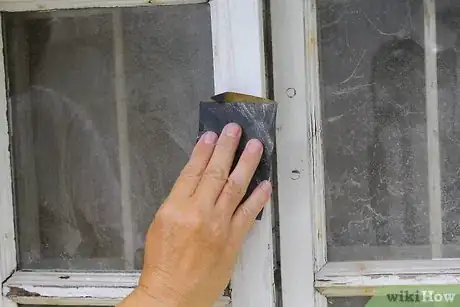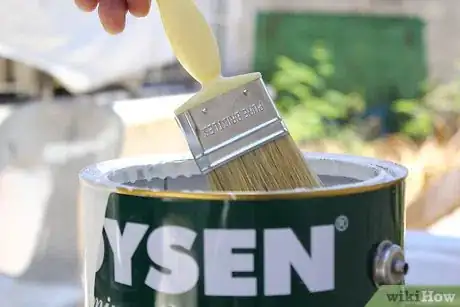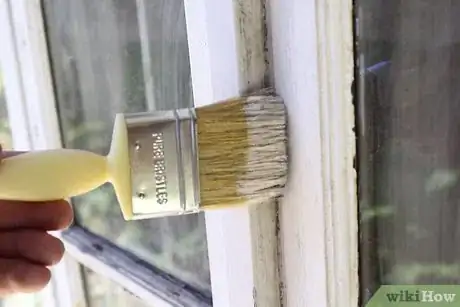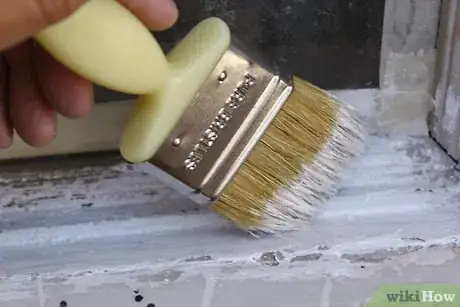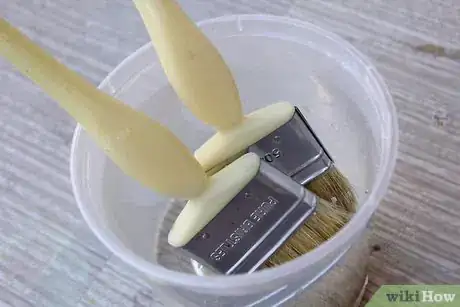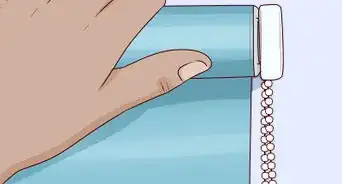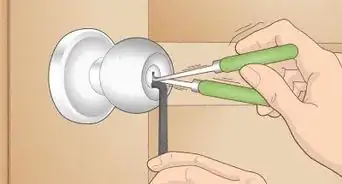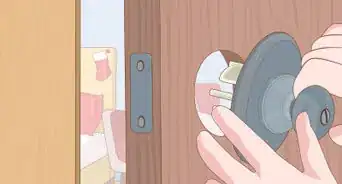This article was co-authored by Archie Guerrero. Archie Guerrero is a Commercial and Residential Painting Specialist and the Operations Manager for DGP Painting in Austin, Texas. With a decade of experience, Archie specializes in interior and exterior painting and staining, cabinet refinishing, and wallpaper and popcorn removal. DGP Painting offers clients environmentally friendly paint materials and top-of-the-line paint products. DGP Painting has an A+ rating with the BBB and has been in Austin’s “Best of the Best.”
There are 8 references cited in this article, which can be found at the bottom of the page.
This article has been viewed 25,583 times.
In a house or an apartment, the interior window trim consists of the wooden molding which comprises the inside of the window frame. This trim is typically about three inches wide, and may also include a protruding windowsill at the bottom of the frame. To paint this trim, you’ll need to sand and prepare the trim itself, then select an appropriate color and type of paint. Make sure to paint all of the surfaces of the window trim, and give the paint time to dry before using the window.
Steps
Selecting a Paint
-
1Decide on a paint color and amount for your interior trim. The color of the paint that you choose is up to you. It’s common to paint interior window trim white, although some people choose to match the trim to the color of the wall, or to paint the trim a contrasting color to draw attention. For example, if you have white walls, you could paint your trim red for a splash of color.[1]
- Don’t be afraid to ask the sales staff at your local paint store for help. They’ll be able to advise you as to the exact color of paint that you should purchase, and can help you choose between brands of paint.
-
2Purchase an acrylic paint. Acrylic paints are the most common variety of paint used for indoor painting, and should be used on your trim. Older, solvent based paints should be avoided; these are less environmentally friendly, and give off less noxious fumes before they dry. Acrylic paints are durable and can be easily cleaned.[2]
- When determining the amount of paint you’ll need to cover your interior window trim, you can use one of many “paint calculators” online. You can also provide an estimate yourself by measuring the area of your indoor trim. One gallon of paint covers about 350 square feet (32.5 square meters).[3]
- The staff at your local paint store can also help you estimate how much paint to buy.
Advertisement -
3Choose semi-gloss or satin finish paint. These are the most popular finishes for interior woodwork painting, and will look good in any type of lighting and on any type of interior wood. A semi-gloss or satin (low-gloss) paint will also help your trim stand out against the surrounding walls, and should be relatively easy to keep clean.[4]
- Although a high-gloss paint will catch your (and your guest’s) eye, it will only look good on high quality and extremely smooth wood. Unless you’re planning to hire a professional painter for the job, avoid using a high-gloss paint.[5]
-
4Purchase a 1.5–2-inch stiff angled brush. A paint-supply store should sell a variety of paintbrushes (and rollers), but for painting window trim, a stiff angled brush will be the most useful tool. The 1.5–2-inch (3.8–5 cm) width should be a good fit for most window trim, and the stiffness of the bristles will prevent them from splaying while in use, and will allow for precise painting.[6]
- If you’re unsure if this particular brush will suit your trim, or have questions about painting brushes in general, ask the sales staff.
Preparing the Wood Trim
-
1Wash the window trim. This will remove any stains or grime from the wooden trim before you paint it. Wash the trim by mixing warm water and a non-soapy detergent in a large bucket. Then, take a scrub sponge (sponge which has an abrasive scrubbing pad on one side), and dip this into the soapy mixture. Gently rub the sponge up and down along the trim, using the scrubbing pad to remove any stubborn stains.[7]
-
2Sand the trim. Once you’ve washed any dirt or grime off of the window trim, you should sand the trim to flatten the surface and prepare it for the paint.[8] You can do this using individual sheets of sandpaper and your hands. There’s no need to use a professional-grade sander. Sand the trim, then rub your fingers along it: the wood should feel completely smooth.[9]
- Since the paint will adhere optimally to the wooden trim if the trim is smooth and has no scratches, you’ll want to use a fine-grain sandpaper for this step. Your local hardware store will stock sandpaper; look for something around 120–180 grit.
-
3Apply painter’s tape around the outside of the frame. In order to protect the wall around the window trim that you’ll be painting, you may want to apply painter’s tape.[10] This papery tape is only mildly adhesive on one side, so can be applied on any wall without stripping paint off. Be sure to place the painter’s tape close against the sides, top, and bottom of the window trim.[11]
- If you’re concerned about dripping paint onto the floor (especially if it’s carpeted), you could also lay down a sheet of plastic beneath the window.[12]
- Painter’s tape should be available at your local hardware store.
Painting the Trim
-
1Pour your paint into a bucket. Pouring the paint into a bucket and then dipping your brush in this container will be more efficient than dipping your brush directly into the paint can. If you don’t pour the entire can of paint into a bucket at once, put the lid lightly back on the paint can so it won’t dry out.[13]
-
2Dip your paintbrush into the paint. When you dip your brush into the paint, only insert the first two inches. Immersing the entire brush head will result in both wasted paint and paint spilling down the brush handle.[14]
- Repeat this dipping and brushing process whenever your brush is running out of paint, or when you begin painting a new section of the trim.
-
3Paint the frame slowly with long and even strokes. This part of painting trim is relatively straightforward. The window frame is made of the pieces of wood (top, sides, and bottom) that outline the window and face directly into the room. The window frame also extends to the inside of the trim (perpendicular to the glass window pane). Dip your brush into the paint, and then apply paint to the frame with long, smooth strokes.[15]
- Don’t rush the painting strokes or paint in short, abrupt strokes. Both of these methods will result in unevenly applied paint, and will look rushed or sloppy once you’ve finished.
-
4Paint the window sash. If you open the window, you’ll reveal the sash. The sash is the section of vertical wooden trim that the lower window pane slides into and out of as it opens. The sash also includes the smaller “frames” of the window sections that slide up and down to open the window. Finally, paint the window casing and the window sills, then let the paint dry. [16]
- Make sure that the paint is fully dried before you lower the window. If you close the window while paint is still wet, the window will become painted shut.
-
5Paint the window trim. The window trim is the roughly ½-inch (1.3-cm) deep “lip,” perpendicular to the glass window pane, that surrounds the wooden window frame. This wood should be painted last, after the front-facing surfaces of the window frame and the sash and trim have been painted.[17]
- Paint the trim from top to bottom. This will allow the paint to drip downwards while you paint higher sections of the trim. You’ll be able to easily paint over and smooth out the places lower down on the trim where paint has dripped.
-
6Clean up your paint and brushes. To tidy up after you’ve finished painting, run your brushes under clean water, preferably from an outdoor spigot. (Running paint down an indoor drain will clog the drain.) Pour unused paint back into the paint can, and rinse out the paint bucket with clean water.
- Don’t put this task off: if you delay cleaning off the brushes and putting the paint away, it could dry. Dried, hardened paint is quite difficult to clean, and you’ll likely need to throw both your brush(es) and bucket away.
Community Q&A
-
QuestionHow do I get a price for painting the trim around the house?
 Community AnswerCall a professional. They will be able to determine the price. Look in your local phone book.
Community AnswerCall a professional. They will be able to determine the price. Look in your local phone book.
Things You’ll Need
- Bucket
- Non-soapy detergent
- Scrub sponge
- Semi-gloss or satin paint
- A stiff angled brush
- Painter’s tape
- Putty knife (optional)
- Spackle (optional)
References
- ↑ https://www.hometips.com/diy-how-to/interior-trim-painting.html
- ↑ https://www.hometips.com/diy-how-to/interior-trim-painting.html
- ↑ http://www.dummies.com/home-garden/home-painting/estimating-how-much-paint-to-buy/
- ↑ https://www.hometips.com/diy-how-to/interior-trim-painting.html
- ↑ http://carlaaston.com/designed/best-paint-trim-high-semi-gloss-satin-enamel
- ↑ http://inmyownstyle.com/2012/02/diy-window-trim-painting-tricks.html
- ↑ https://www.familyhandyman.com/painting/how-to-prepare-wood-trim-for-a-smooth-paint-job/view-all
- ↑ Archie Guerrero. Commercial & Residential Painting Specialist. Expert Interview. 17 June 2021.
- ↑ https://www.familyhandyman.com/painting/how-to-prepare-wood-trim-for-a-smooth-paint-job/view-all
- ↑ Archie Guerrero. Commercial & Residential Painting Specialist. Expert Interview. 17 June 2021.
- ↑ http://inmyownstyle.com/2012/02/diy-window-trim-painting-tricks.html
- ↑ Archie Guerrero. Commercial & Residential Painting Specialist. Expert Interview. 17 June 2021.
- ↑ http://www.behr.com/consumer/how-to/interior/how-to-paint-a-window
- ↑ http://www.behr.com/consumer/how-to/interior/how-to-paint-a-window
- ↑ http://www.behr.com/consumer/how-to/interior/how-to-paint-a-window
- ↑ http://www.behr.com/consumer/how-to/interior/how-to-paint-a-window
- ↑ http://www.behr.com/consumer/how-to/interior/how-to-paint-a-window
- ↑ https://www.familyhandyman.com/painting/how-to-prepare-wood-trim-for-a-smooth-paint-job/view-all
- ↑ https://www.familyhandyman.com/painting/how-to-prepare-wood-trim-for-a-smooth-paint-job/view-all
